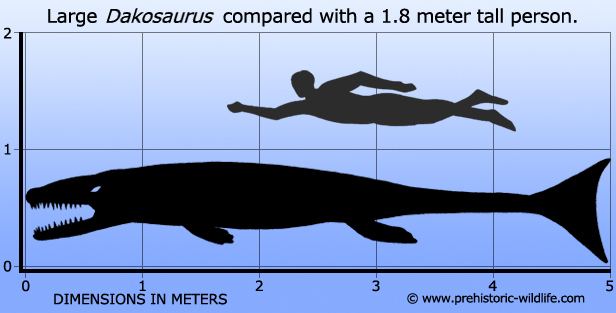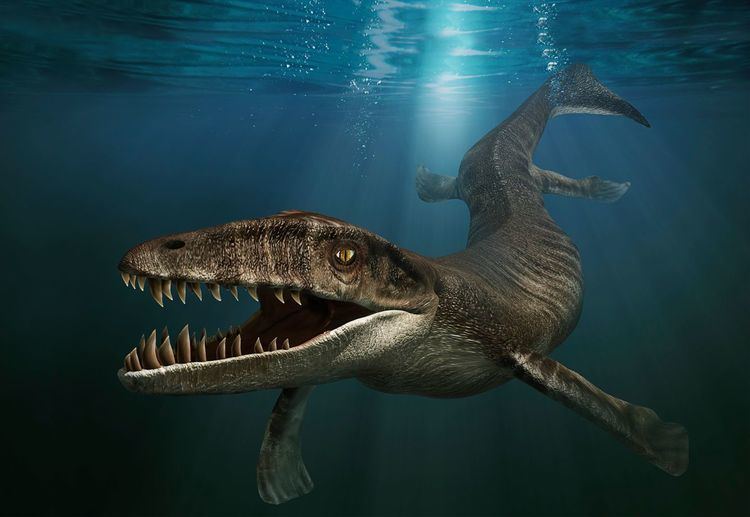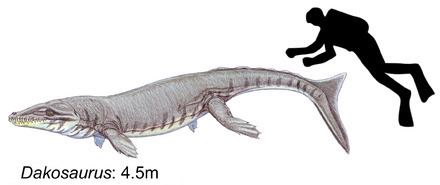Tribe †Geosaurini | Phylum Chordata Scientific name Dakosaurus Rank Genus | |
 | ||
Similar Geosaurus, Metriorhynchidae, Metriorhynchus, Reptile, Thalattosuchia | ||
Dakosaurus level 40 jurassic world the game aquatic update
Dakosaurus is an extinct genus within the family Metriorhynchidae that lived during the Late Jurassic and Early Cretaceous. It was large, with teeth that were serrated and compressed lateromedially (flattened from side to side). The genus was established by Friedrich August von Quenstedt in 1856 for an isolated tooth named Geosaurus maximus by Plieninger. Dakosaurus was a carnivore that spent much, if not all, its life out at sea. The extent of its adaptation to a marine lifestyle means that it is most likely that it mated at sea, but since no eggs or nests have been discovered that have been referred to Dakosaurus, whether it gave birth to live young at sea like dolphins and ichthyosaurs or came ashore like turtles is not known. The name Dakosaurus means "biter lizard", and is derived from the Greek dakos ("biter") and σαῦρος -sauros ("lizard").
Contents
- Dakosaurus level 40 jurassic world the game aquatic update
- Discovery and species
- Valid species
- Unnamed species
- Taxonomy and phylogeny
- Morphology
- Salt glands
- Niche partitioning
- Diet
- References

Discovery and species

When isolated Dakosaurus teeth were first discovered in Germany, they were mistaken for belonging to the theropod dinosaur Megalosaurus. In 1856 von Quenstedt made Plieninger's Geosaurus maximus teeth a new genus with the name Dakosaurus. He explained the etymology as Greek dakos "Biss" [bite] in 1858 in German, adding "denn wenige kommen seinem furchtbaren Gebiss gleich” [for few can match its terrible set of teeth]. He gave the meaning of Greek dakos more correctly as "Beisser" [biter] in another description in 1859 in which he classified Dakosaurus as a dinosaur.

Fossil specimens referrable to Dakosaurus are known from Late Jurassic deposits from England, France, Switzerland, Germany, Poland, Russia, Argentina, and Mexico. Teeth referrable to Dakosaurus are known from Europe from the Oxfordian.
Valid species

The type species Dakosaurus maximus, meaning "greatest biter lizard", is known from fossil discoveries in Western Europe (England, France, Switzerland and Germany) of the Late Jurassic (Late Kimmeridgian-Early Tithonian).
Dakosaurus andiniensis, meaning "biter lizard from the Andes", was first discovered in 1987 in the Neuquén Basin, a very rich fossil bed in Argentina. However, it was not until 1996 that the binomen Dakosaurus andiniensis was erected. Two recently discovered skulls have indicated that D. andiniensis is unique among the metriorhynchids (the family of stem-crocodilians most specialised for marine life) with its short, tall snout, which lent it the popular nickname "Godzilla" in press reports about its description. This species has a fossil range from the late Jurassic to early Cretaceous (Late Tithonian-Early Berriasian).
Dakosaurus nicaeensis, named in 1913 by Ambayrac, was mistakenly classified as a megalosaurid dinosaur; now it is assigned as the sole species in the genus Aggiosaurus. Buffetaut in 1982 demonstrated that it was in fact a metriorhynchid, closely related to, if not a member of Dakosaurus. As the type specimen is poorly preserved it is considered nomen dubium. In 2009, Young and Andrade published a re-description of Geosaurus, examining its relationships and the validity of species lumped into the genus.
Unnamed species
Incomplete skull specimens of Dakosaurus have been discovered in Kimmeridgian age rocks from Mexico.
Taxonomy and phylogeny
Dacosaurus is a misspelling of Dakosaurus, and thus a synonym.
Recent phylogenetic analysis does not support the monophyly of Dakosaurus, although the species D. maximus and D. andiniensis do constite a natural group.
Cladogram after Cau & Fanti (2011).
The cladogram below follows a subsequent analysis by Young et al. (2011).
Morphology
All currently known species would have been approximately 4 to 5 metres in length, which when compared to living crocodilians, Dakosaurus can be considered large-sized. Its body was streamlined for greater hydrodynamic efficiency, which along with its finned tail made it a more efficient swimmer than modern crocodilian species.
Salt glands
The incomplete skull specimens from the Mexican species of Dakosaurus preserves the chamber in which the well-developed salt glands (known from Geosaurus and Metriorhynchus) would have been housed. Unfortunately, there was no preservational evidence of the glands themselves.
Niche partitioning
Dakosaurus maximus is one of several species of metriorhynchids known from the Mörnsheim Formation (Solnhofen limestone, early Tithonian) of Bavaria, Germany. Alongside three other metriorhynchid species, it has been hypothesised that niche partitioning enabled several species of crocodyliforms to co-exist. Dakosaurus and Geosaurus giganteus would have been top predators of this Formation, both of which were large, short-snouted species with serrated teeth. The remaining two species (Cricosaurus suevicus and Rhacheosaurus gracilis) and the teleosaurid Steneosaurus would have fed mostly on fish.
From the slightly older Nusplingen Plattenkalk (late Kimmeridgian) of southern Germany, both D. maximus and C. suevicus are contemporaneous. As with Solnhofen, Dakosaurus was the top predator, while C. suevicus was a fish-eater.
Diet
Dakosaurus was the only marine crocodyliform to have evolved teeth both lateromedially compressed and serrated; not only that, but they were much larger than those of metriorhynchid genera. These characteristics, along with their morphology falling into the 'Cut' guild of Massare (1987) - which are analogous to modern killer whale teeth - are indicative of Dakosaurus being an apex predator.
The enlarged supratemporal fenestrae of Dakosaurus skulls would have anchored large adductor muscles (jaw closing), ensuring a powerful bite. As their skulls are triangular in shape, with deeply rooted large, serrated teeth and a bulbous, deep mandibular symphysis (like pliosaurs), dakosaurs would also have been able to twist feed (tear chunks of flesh of potential prey).
